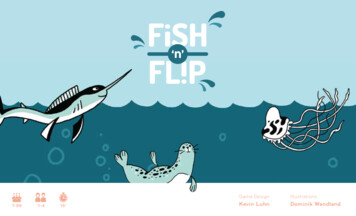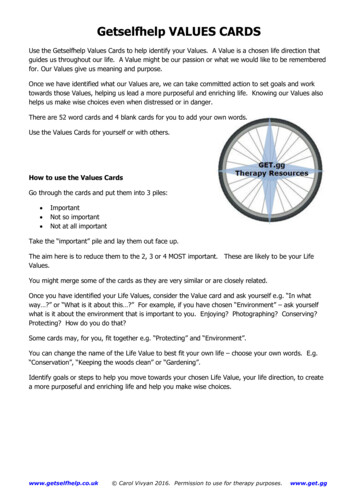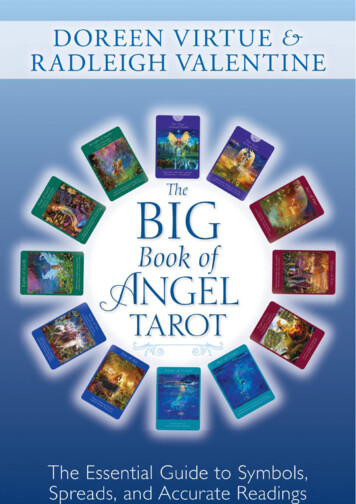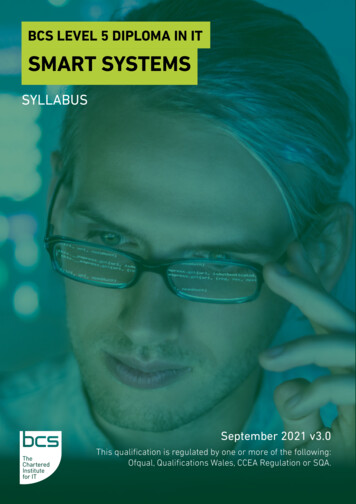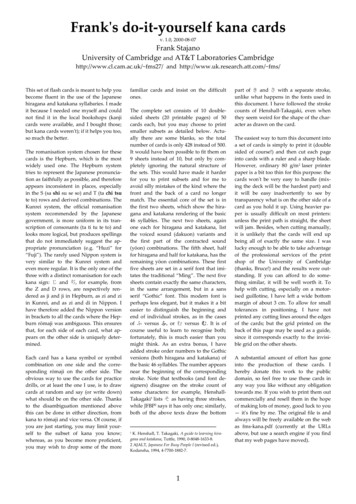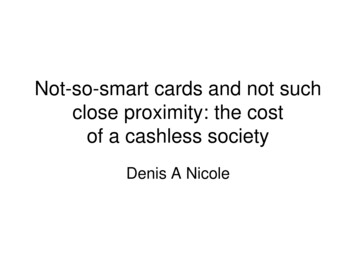
Transcription
Not-so-smart cards and not suchclose proximity: the costof a cashless societyDenis A Nicole
Abstract"A not very technical review of thevulnerabilities of the current mainstreamtechnologies driving the cashless society.Scissors† will be provided if you decide tocut up your cards here and now. Almostno new research will be presented."† The ISO14443 standard says that you can disable a proximity card bycutting to where the Chip would be if it were a Chip & PIN
ScopePractical attacks on the two most popular eMoneysystems: CHIP & PIN ISO14443/mifare: Oyster, Passports etc. with lots of thanks to Ross Anderson’s group atCambridge:http://www.lightbluetouchpaper.org
CHIP & PINBackground: It’s hard to clone a chip It’s easy to clone a magstripe Currently, most fraud is claimed to be ofthe Card not Present type, eg the innocentvictims of Operation Ore—there is morethan your money at stake. There are also a lot of foreign ATMtransactions.
No evidence against man in child porn inquiry who 'killed himself'By Ian HerbertPublished: 01 October 2005The credibility of a major investigation into child pornography came under renewed scrutiny yesterdayafter an inquest into the death of a naval officer who was suspended by the Royal Navy despite alack of evidence against him.The Navy suspended Commodore David White, commander of British forces in Gibraltar, after policeplaced him under investigation over allegations that he bought pornographic images from awebsite in the US. Within 24 hours he was found dead at the bottom of the swimming pool at hishome in Mount Barbary.The inquest into his death heard that computer equipment and a camera memory chip belonging toCommodore White had yielded no evidence that he downloaded child pornography, and a letterwas written by Ministry of Defence police to Naval Command on 5 January this year indicatingthat there were "no substantive criminal offences" to warrant pressing charges. But the SecondSea Lord, Sir James Burnell-Nugent, feared that the media would report the case and on 7January removed him from his post anyway.Despite accepting the news in a "steady fashion", the commodore was dead the next day. His brotherRupert told the inquest that the news of his removal had caused his "mental collapse", and that hewas in "a state of catatonic shock".Of course, if you’re not driven to suicide your neighbours might kill youwhen your identity is leaked.
CHIP & PIN:Fundamental problems Multiple protocols: Chip, magstripe, CVV2 Man in the middle Short PINs, entered in public
Credit card protocols 1: CVV2 Account CVV2, used for card not present:easily skimmed by the dumbest crook.Why is the CVV2 printed on the card? card not present is not a problem for the Banks.If you don’t notice, they keep the 2%†; if you do,they charge back from the business and chargeit another‡ fee.† yment-services.htm‡ Fraud Frenzy, Tonight with Trevor MCDonald, 2007-05-04
And you have no recourseFraud victims told: Go to the bank, NOT the police30.03.07Victim of fraud: Don't bother reporting it to the policeHundreds of thousands of people who fall victim to credit or debit card fraudhave been told to no longer bother reporting it the police.From Sunday a change in the law, which has been approved by the HomeOffice, means victims should go to their bank rather than the police station.The move has been condemned as "astounding" by security experts whosuggest it amounts to the privatisation of the justice system.They say it appears an attempt by the Government, the police and the banks topush the crime, which costs the nation 428 million a year, under thecarpet.The changes are contained in the small print of the 2006 Fraud Act, whichcomes into force on April 1 - April Fools' the%20bank,%20NOT%20the%20police/article.do
Credit card protocols 2: MagstripeThere are three tracks on themagstripe. Each track is .110inch wide. The ISO/IECstandard 7811, which is usedby banks, specifies: Track one is 210 bits per inch(bpi), and holds 79 six-bit plusparity bit read-only characters. Track two is 75 bpi, and holds40 four-bit plus parity bitcharacters. Track three is 210 bpi, andholds 107 four-bit plus paritybit characters. Most cheapreaders do not read this track.Easy for all to read and write: myunit cost 5.Throw away everything you thought youknew about credit card readers.You've found the IntelliSwipe CC -- thesmart, easy-to-use credit card reader thatanyone can use. Just plug it into any USBport and swipe a card, and the informationwill be typed into any application as ifentered on the keyboard, in the format youspecify (we offer a few different outputformats you can choose when ordering).
Track 1 Start sentinel “%” -- 1 characterFormat code "B" -- 1 character (alpha only)Primary account number -- up to 19 charactersSeparator “ ” -- 1 characterCountry code “826” -- 3 charactersName -- 2-26 charactersSeparator “ ” -- 1 characterExpiration date -- 4 characters or 1 characterDiscretionary data -- enough characters to fill out maximum recordlength (79 characters total), this includes the CVV1 End sentinel “?” -- 1 character Longitudinal Redundancy Check -- 1 characterhttp://www.gae.ucm.es/ padilla/extrawork/tracks.htmlThe PIN offset is on tracks 2 and 3.
And easy to rip off UK ATMs continued to use mag stripe after retailers were “forced”†to switch to Chip & PIN. Many current systems will fall back to the stripe if the Chip hasfailed. Foreign ATMs still use the stripe. Stripe data can be reconstructed from open data on the Chip.Why does the mag stripe have the same PIN as the Chip?† On Valentine’s day 2006 responsibility for fraudulent transactions wastransferred to the merchants if they didn’t have Chip & PIN.
Grabbing a PIN PINs used to be used only in the “controlled”environment of an ATM. Most shop readers are overlooked by PoSCCTV. It’s almost impossible to conceal button pressesas keypads differ between machines. They’realso starting to wear out, so you need to be ableto see the screen while concealing the keypad.Why no standard key shapes?
PIN machine in the middle The machinesare tamperevident to theBank, not to you. Buy one onEbay
Either add a transaction, or stealstripe data and PIN: your ojects/banking/relay/
Or just havefunhttp://www.youtube.com/watch?v wWTzkD9M0sU
Tesco and B&Q relay for you Both merchants use separated cardreader and PIN entry, On UK cards, thePIN is not encrypted on the wire to thecard. In the jargon, we use SDA, not DDA,‘cos it’s cheaper. Halfords take a swipe for good measureafter the transaction.
They reply
Bank ‘security’ Some anti-skimming devices on ATMs justjiggle the card; so learn DSP. PINsentry
Barclays' chip and PIN readers will work for other banksPINsentry will read all APACS-standard cardsBy OUT-LAW.COMPublished Monday 23rd April 2007 09:20 GMTBarclays Bank is introducing a handheld chip and PIN card reader for the home in an escalation of its online bankingsecurity. Other chip and PIN cards will work with the Barclays device, not just cards issued by Barclays.Barclays has designed its system in accordance with standards issued by payment association APACS. Barclays saysit will be the first deployment of its kind in the UK for personal banking customers. By conforming to the APACSstandard the reader can be used as part of any system also using those standards. Not all chip and PIN cardsconform to the standard at present.In July the bank will begin sending half a million card readers to its home users. It is not charging customers for thedevices, which it is calling PINsentry. They will be compulsory for those who wish to transfer money to third partybank accounts."The remaining customers will not need PINsentry at this stage – it will only be needed by those who use onlinebanking to set up payments out of their account to a new third party for the first time," said a Barclays statement."Customers who simply wish to use online banking to view their accounts and pay bills or established payees willbe able to continue to use online banking as normal without the need for PINsentry."A Barclays spokeseman told OUT-LAW that the card readers, manufactured by Dutch security specialist Gemalto, willbe sent to other customers who request one, even if they do not transfer money to third party bank accounts.First transactions to third party accounts are being targeted for extra security because that is the outlet for any stolenmoney should a thief break into someone's online bank account.When a customer inserts a card into the PINsentry reader and enters the correct PIN, the device will generate an eightdigit number. That number must be typed in to the bank's website. For security, the card reader will not connect toa computer. For visually-impaired users, a larger card reader will be available that includes a loud speaker and aheadphone jack.PINsentry users will be asked to enter the eight digit number at login, even just to view account details. This means thatto access their account details at work, customers must carry the readers with them. Upon instructing a transfer toa third party account for the first time, the user will be asked to generate another number and enter that jsp/brccontrol?site pfs&task homefreegroup&value 12422
won’t help If it uses the same class of eight digit codefor an initial login and to authorize a newthird party all the man-in-the-middle has to do issimulate a dropped session and request anew login.
The Bank mightjust be ineptHow ATM fraud nearly brought down British bankingPhantoms and rogue banksBy Charles ArthurPublished Friday 21st October 2005 09:52 GMTThis is the story of how the UK banking system could have collapsed in the early 1990s, but for theforbearance of a junior barrister who also happened to be an expert in computer law - and whodiscovered that at that time the computing department of one of the banks issuing ATM cards had"gone rogue", cracking PINs and taking money from customers' accounts with abandon. "Stone had been working with building access systems using cards with magnetic stripes, and one dayhe thought he'd see what it could read of his ATM card. Then he tried it with his wife's." Stonefigured that the stream of digits was probably an encrypted PIN."Then, because you can change the content of the magnetic strip, he wondered what would happen ifhe changed the number on his card to match his wife's. He found he could get money out usinghis old PIN." The high street bank Stone used (The Register knows which one) had not used theaccount number to encrypt the PIN on the card - meaning that any card for that bank could bechanged and used to make withdrawals on any other account in it, providing you knew the rightdetails (such as branch sort code and account number. The name of the card holder of coursewas unimportant, because it was not on the stripe.)
Or corrupt On 22 June 1993, Judge Hicks gave judgement, mostly in favour of themotion by Kelman, who expected the banks to simply settle.But a few days later Kelman heard something that worried him deeply.The computing staff at one bank - the Rogue bank - had discoveredthrough the dummy accounts how to fix the PIN generator so that itwould only generate three different PINs in all the PINs issued. Bycreating a number of dummy accounts and getting new PINs issuedfor them, they could capture the sequence. Then all that wasneeded was to recode the cards so they would point to differentaccount numbers, try the three PINs (ATMs gave you threechances) and they were away.
mifare The standard ISO14443 protocol for 13.56MHzproximity cards Widely used: Oyster, passports There isn’t much power, so the cards use aPhilips proprietary symmetric stream cipher:CRYPTO1; there are some rumours it has beenreverse engineered in China. Other rumourssuggest it is triple-DES-like. Philips also try to restrict access to the readerchip specs but not the CL RC632
Access control Much access control relies on the card ID,part of the public protocol, like a MACaddress. Just build your own card easywith a battery. Passports use a randomised ID todiscourage people-tracking.
General thievery Man-in-the-middle works for me A Practical Relay Attack on ISO 14443 Proximity Cards,Gerhard Hanckehttp://www.cl.cam.ac.uk/ gh275/relay.pdf
Is there a legitimate use for a keylogger?The print catalogue says: You should not use this device to intercept data you are notauthorised to possess, especially passwords, banking data, confidential correspondenceetc. Most countries recognise this as a crime
More links A generic reader:http://cq.cx/proxmark3.pl Some ww.rfidguardian.org/ es/news/2006/08/71521 Banking Organisations:EMVCo: Europay, Mastercard and Visa,publishers of the Chip & PIN standards.Society for Worldwide Interbank Financial TelecommunicationAPACS
PINsentry will read all APACS-standard cards By OUT-LAW.COM Published Monday 23rd April 2007 09:20 GMT Barclays Bank is introducing a handheld chip and PIN card reader for the home in an escalation of its online banking security. Other chip and PIN cards will work with the Barclays device, not just cards issued by Barclays.


